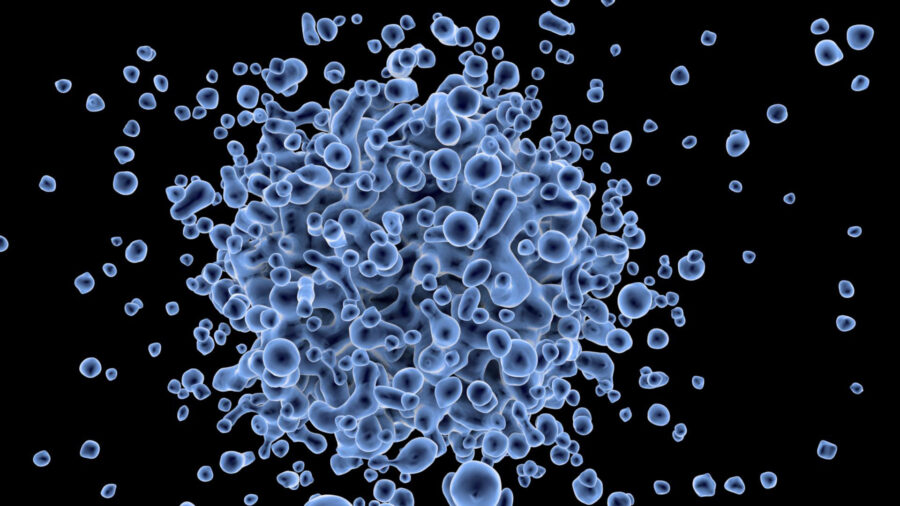Cancer Cure News: Latest Scientific Breakthroughs To Beat The Disease
These are the most promising cancer cures currently making waves in the scientific and medical community.
This article is more than 2 years old
Cancer. Just the thought of that word can bring the strongest to their knees. The disease has many forms, can hit so many areas of the body and is relentless if not found quickly enough. It can also be relentless if it IS found quick enough. The battle to defeat the disease rages on but in the world of cancer cure news the future has never looked brighter.
While radiation and chemotherapy continue to be used to combat cancer, scientists and doctors are coming up with promising new ways to attack it. These are the most promising cancer cures currently making waves in the scientific and medical community.

IMMUNOTHERAPY In Cancer Cure News
Immunotherapy is not one specific way to combat cancer, but many different ways. This treatment uses parts of a patient’s immune system in various ways to attack cancer in hopes to eradicate it permanently. It can be used to stimulate the immune system allowing it to work smarter and harder against cancer. It can also be used by giving the immune system man-made components to destroy cancer cells. Immunotherapy reacts differently to whatever cancer they are fighting. In some cancers, immunotherapy is used alone in the fight, in other cancers, immunotherapy is used together with other types of treatment for better results.
CAR T-CELL THERAPY
The CAR T-cell therapy, a type of immunotherapy, has been labeled as a miracle in the world cancer cure news. But what is this miracle cure-all about? It would first be helpful to understand exactly what a T cell is and why it’s so important. T cells are a type of white blood cells or lymphocyte that develops on the thymus gland. T cells are extremely important to our immune system. They act like soldiers in a war as they have the ability to search and destroy bad cells within the body. There are 4 main types of T cells produced in the body. Memory T cells, Natural Killer T cells, CD4+ Helper cells, and CD8+ Cytotoxic cells. The importance of CD8+ being cytotoxic is that it is able to kill cancer cells.
T cell engineering began decades ago but it wasn’t until the past decade and a half that the first effective CAR T-cell was developed. Since that time, scientists have been perfecting this which leads us to CAR T-cell therapy. This treatment takes a patient’s T-cells and has them changed in a laboratory so they can attack cancer cells. The T-cells are removed from the patient’s blood and then in the lab, a gene is added. This gene is a special receptor or a CAR (chimeric antigen receptor). This receptor binds itself to a certain protein within the patient’s cancer cells.
These CAR T-cells are grown in large numbers in the lab and then infused within the patient. These engineered T cells then recognize a specific molecule on a tumor cell. The T cell is then stimulated, prompting it to attack the cancer cell.
The clinical trials for the CAR T have shown huge remission rates, as high as 94%, in the most severe forms of blood cancer, which per recent FDA approval, are the only forms of cancer the CAR T is fighting. And while adult B-cell non-Hodgkin’s lymphoma and childhood acute lymphoblastic leukemia are on the current menu, the next phase of CAR T has indolent B-cell lymphoma, mantle cell lymphoma, multiple myeloma and acute myeloid leukemia set squarely in its sight.
While to many this is the miracle cure, the CAR T-Cell Therapy is not without its downside. The side effects to this treatment can sometimes be severe and unfortunately lethal. The most common side effect is one that causes flu-like symptoms called cytokine release syndrome. Around 70-90% of patients experience CRS but it’s a short-term effect lasting five to seven days. Another known side effect is CAR T-cell-related encephalopathy syndrome. Patients become disoriented and confused about five days after infusion. Some patients weren’t able to speak at all for a few days. This lasts a short time, a couple of days and patients do recover their neurological functions.
With all this, CAR T-Cell Therapy is an exciting treatment in the non-ending fight against cancer.
CANCER VACCINES
Another type of immunotherapy is cancer vaccines and there are two types, prevention and treatment vaccines. Prevention vaccines are given to healthy patients to prevent them from developing certain types of cancer. For instance, the HPV (human papillomavirus) vaccine is given to help prevent cervical, vaginal and vulvar cancers in women. It also prevents anal cancer. The hepatitis B vaccine is given to prevent hepatitis B, which its long-lasting infection can cause liver cancer.
Treatment vaccines are given to help boost a patient’s immune system, allowing it to help fight off certain cancers. They are given to patients who have already been diagnosed with cancer. Substances that are on the surface of cells are called antigens. Cancer cells have certain molecules that produce cancer-specific antigens that aren’t seen on healthy cells. So, a vaccine can be created to act as these antigens to stimulate the immune system, allowing it to recognize and destroy any cancer cells that have these molecules on their surface.
At the present time, the FDA has approved only one vaccine treatment which is for men diagnosed with metastatic prostate cancer. Clinical trials, though, are available for most cancer types in hopes to get more FDA approval for these cancer vaccines. The following cancers are being tested through clinical trials: bladder, breast, cervical, colorectal, kidney, leukemia, lung, melanoma, brain tumors, myeloma, pancreatic, and prostate.
One company, BioNTech, is in the process of developing therapeutic vaccines that are built specifically for each tumor. As Sean Marett, CBO and CCO of the company explained to Labiotech.eu, “Each patient gets a tailor-made product just for them.”
CHECKPOINT INHIBITORS In Cancer Cure News
Checkpoint inhibitors are another form of treatment that has seen great results and has been the reason for thousands of clinical trials. A checkpoint inhibitor is a molecule that blocks immune checkpoints. These molecules are important because they modulate our immune system’s response to cancer. In many cancers, they use these checkpoints to virtually hide from the immune system. The use of an inhibitor blocks the checkpoint, thus releasing the brakes on the immune system, allowing the immune system to work against specific cancer.
In our immune system, checkpoints are normal. They prevent a strong response from our immune system so that it won’t kill healthy cells. But these inhibitors go in and block checkpoint proteins from binding, allowing T cells to kill cancer cells. Bladder, breast, cervical, colon, head and neck, liver, lung, Hodgkin lymphoma, renal cell, skin, stomach, and rectal cancers are among the cancers that immune checkpoint inhibitors have been approved to treat some patients. Of course, with all drugs, side effects can occur. The same with these inhibitors. Common side effects include fatigue, rash, and diarrhea with more serious problems in the kidneys, liver, intestines, lungs, or possibly other organs.
HOT and COLD In Cancer Cure News
These are two forms of treatment that use opposite ends of the spectrum to obtain the same results. Cryotherapy uses a needle-like applicator along with argon gas or liquid nitrogen to go after cancer cells. The creation of the intense cold will destroy cancer cells. Cryotherapy is used for skin tumors, retinoblastomas, prostate, cervical and liver cancers.
Radiofrequency ablation destroys cancer cells with the use of electrical energy and heat. This is done by a thin needle being placed into the cancerous tissue then high-frequency energy is sent through the needle causing the surrounding tissue to heat up, killing the nearby cancer cells. This type of treatment is mainly used to treat a spot of cancer seen in the adrenal glands, breast, bone, kidney, liver, lung, pancreas or thyroid. This option is mainly considered if
CRISPR As A Possible Cure
The quest to find that the ultimate cure for cancer will not stop. As technology advances, the potential for cures seems to be much closer. One exciting piece of technology in its infancy uses genome editing. It’s called CRISPR (clusters of regularly interspaced short palindromic repeats) and this bit of technology is a simple, yet powerful, tool used to edit genomes. It allows for easy alteration of DNA sequences by researchers where they can also modify gene function. The goal of this is similar to CAR T-cell therapy in that researchers wish to help immune cells latch on to and destroy cancer cells.
University of Pennsylvania professor of immunotherapy Dr. Carl June said in a statement, “Our use of CRISPR editing is geared toward improving the effectiveness of gene therapies, not editing a patient’s DNA.” This research is in its early stages as only three patients have started this treatment. Dr. Edward Stadtmauer, a professor of oncology also at the University of Pennsylvania wanted to stress that this first trial wasn’t designed on whether its approach actually works, but whether it is safe and feasible. He said, “This is a very important first step. We hope this is the beginning of the next generation of engineering cells to help many different diseases and many different tumors.” Dr. Stadtmauer then added, “This treatment is not ready for prime time. But it is definitely very promising.”
Illuminated Nanoparticles In The News
Another promising treatment on the horizon involves the use of illuminated nanoparticles which heat and destroy tumors. This technique is called photothermal cancer therapy. Rice University invented this therapy a decade ago and saw it recently cross a milestone in clinical trials. Of the 15 patients they treated with this technique for prostate cancer, 13 of them have shown no detectable signs of cancer one year after treatment. The treatment, called AuroLase Therapy, is a two-dayer, the first day involves the patient receives their nanoparticles via intravenous infusion and day two they undergo image-guided ablation treatment. The trial continues with much promise.
The Fight To Eradicate Cancer
Breast, colon, prostate, pancreatic, basal cell or lung. Add cancer to the end of those words and for many, it’s historically been a death sentence. Lymphoma, leukemia or melanoma. The other forms of the disease that don’t require “cancer” being added to them. Wherever the disease hits, your body is in for a fight. Not only does it affect those who carry the disease, but it also affects the loving people who deal with the disease alongside them.
Over the past few decades, the fight against cancer has been as relentless as the disease itself. Billions of dollars have been put forth in hopes to eradicate this brutal killer. Radiation and chemotherapy long been used in hopes of killing the disease. Surgery also has been used to remove it completely from the body. These options have always been met with varied results. Sometimes the results are lifesaving. Sometimes the results just delay the inevitable. Luckily there is progress beyond those traditional treatments and cancer cure news continues to improve as doctors and scientists push for the ultimate cure. Various immunotherapies look to offer our best solution yet, and as research continues the future looks bright.












